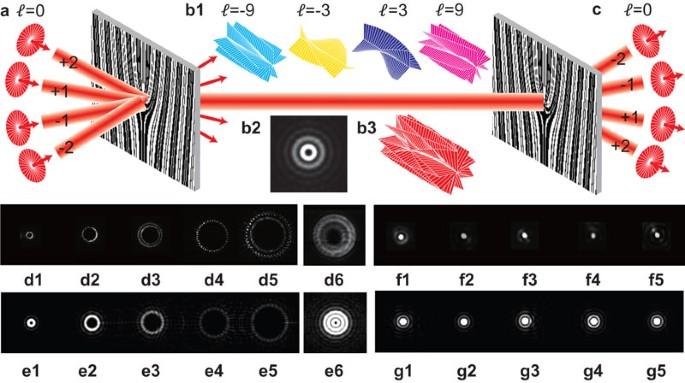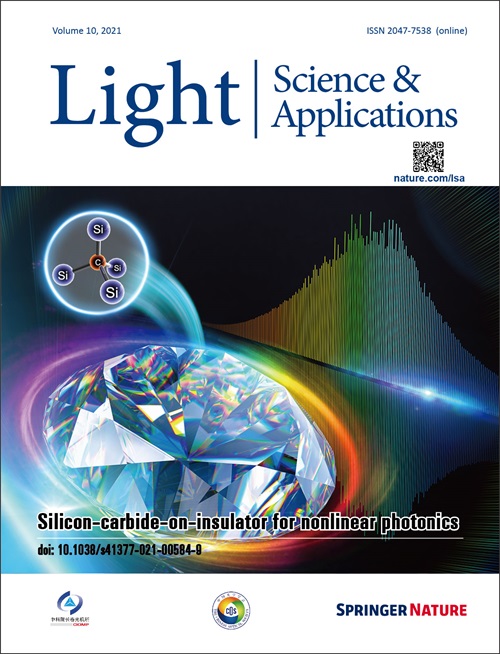Massive individual orbital angular momentum channels for multiplexing enabled by Dammann gratings
IF 19.4
1区 物理与天体物理
Q1 Physics and Astronomy
引用次数: 380
Abstract
Data transmission rates in optical communication systems are approaching the limits of conventional multiplexing methods. Orbital angular momentum (OAM) in optical vortex beams offers a new degree of freedom and the potential to increase the capacity of free-space optical communication systems, with OAM beams acting as information carriers for OAM division multiplexing (OAM-DM). We demonstrate independent collinear OAM channel generation, transmission and simultaneous detection using Dammann optical vortex gratings (DOVGs). We achieve 80/160 Tbit s−1 capacity with uniform power distributions along all channels, with 1600 individually modulated quadrature phase-shift keying (QPSK)/16-QAM data channels multiplexed by 10 OAM states, 80 wavelengths and two polarizations. DOVG-enabled OAM multiplexing technology removes the bottleneck of massive OAM state parallel detection and offers an opportunity to raise optical communication systems capacity to Pbit s−1 level. Dammann gratings are used to realize multiplexing based on the generation, transmission and detection of optical angular momentum (OAM). The OAM of optical vortex beams offers a new degree of freedom for multiplexing and hence the promise of higher data communication rates, but massive parallel detection of OAM states has proved challenging. Now, researchers in China, Australia and Singapore have used Dammann optical vortex gratings (DOVGs) to realize multiplexing of massive OAM channels with individual modulation and simultaneous detection capabilities. They achieved a data capacity of 80 Tbit s−1 by multiplexing 1600 channels using ten OAM states, 80 wavelengths and two polarizations. This DOVG-enabled OAM multiplexing technology removes the bottleneck of massive parallel detection of OAM states and has the potential to increase optical communication capacities to the Pbit s−1 level.

利用达曼光栅实现多路复用的大规模单个轨道角动量通道
光通信系统的数据传输速率已接近传统复用方法的极限。光涡旋光束中的轨道角动量(OAM)为自由空间光通信系统提供了新的自由度和提高容量的潜力,OAM光束可作为OAM分复用(OAM-DM)的信息载体。我们利用达曼光涡旋光栅(DAVGs)演示了独立共线 OAM 信道的生成、传输和同步检测。我们利用 1600 个单独调制的正交相移键控 (QPSK)/16-QAM 数据通道,通过 10 个 OAM 状态、80 个波长和两个极化进行复用,实现了 80/160 Tbit s-1 的容量,且所有通道的功率分布均匀。采用DOVG的OAM复用技术消除了大规模OAM状态并行检测的瓶颈,为将光通信系统的容量提高到Pbit s-1水平提供了机会。达曼光栅用于实现基于光角动量(OAM)产生、传输和检测的多路复用。光涡旋光束的光角动量为多路复用提供了新的自由度,从而有望实现更高的数据通信速率,但对光角动量状态进行大规模并行检测已被证明具有挑战性。现在,中国、澳大利亚和新加坡的研究人员利用达曼光涡旋光栅(DAVG)实现了具有单独调制和同步检测能力的大规模OAM信道的复用。他们利用10种OAM状态、80个波长和两种偏振复用了1600个信道,实现了80 Tbit s-1的数据容量。这种支持 DOVG 的 OAM 复用技术消除了 OAM 状态大规模并行检测的瓶颈,有望将光通信容量提高到 Pbit s-1 级别。
本文章由计算机程序翻译,如有差异,请以英文原文为准。
求助全文
约1分钟内获得全文
求助全文
来源期刊

Light, science & applications
OPTICS-
CiteScore
27.00
自引率
2.60%
发文量
331
审稿时长
20 weeks
期刊介绍:
Light: Science & Applications is an open-access, fully peer-reviewed publication.It publishes high-quality optics and photonics research globally, covering fundamental research and important issues in engineering and applied sciences related to optics and photonics.
 求助内容:
求助内容: 应助结果提醒方式:
应助结果提醒方式:


